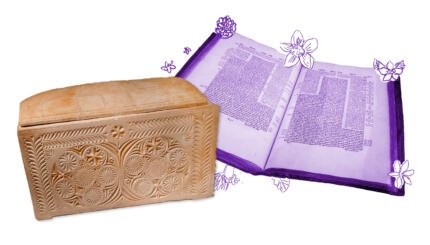Long ago, there were no funeral homes to handle dead bodies and people were not even buried in coffins. Rather, the deceased, who likely died at home, were carried out the door on a bier, supported by relatives and friends, and would eventually be brought outside the city for burial. On the way, as we learn today, it was customary to rest the bier in the street, allowing neighbors to gather and recite eulogies and stamp their feet in grief (the rabbis warn that one should wear shoes and not sandals for this ritual). During this time, the whole town, or at least a portion of it, refrained from work.
A common thread on today’s page is the concern that everyone should be treated with dignity at the end. Since the poor could not afford expensive biers and burial clothes, the rabbis instituted that all, even the rich, should be carried on plain biers and buried in simple linen shrouds. Similarly, since famine blackened the faces of those who died of starvation, the rabbis instituted that all faces were covered in death, so no one would see whose face was disfigured by malnutrition. Those who died of intestinal disease smelled terrible so their bodies were accompanied by incense — and therefore so was everyone else. And so on. All were equal in death.
These practices — that honor the dead and the dignity of all — make sense to me. But there’s a story on today’s page that I found much more difficult to understand. It is brought as a warning against grieving too much.
A certain woman who lived in the neighborhood of Rav Huna had seven sons. One of them died and she wept for him excessively. Rav Huna sent a message to her: “Do not do this.” But she took no heed of him. He then sent another message to her: “If you listen to me, it is well, but if not, prepare shrouds for another death.” And they all died. In the end, he said to her: “Prepare shrouds for yourself” — and soon thereafter she died.
With your help, My Jewish Learning can provide endless opportunities for learning, connection and discovery.
Jewish mourning practices — which take the mourner through several stages, from acute grief to less intense mourning and, finally, full reentry into the world — are renowned for their psychological sensitivity. Mourning is a process, these practices remind us, and has many stages. Mourners must be given time.
But according to the rabbis, there’s such a thing as too much time — and the woman in this story has entered that territory. Rav Huna encourages her to wind down her grief and rejoin the living, but she either will not or cannot. Rather than offer comfort, he issues a terse warning that proves prescient. In the end, she is punished for grieving too long: first with the death of her other sons, and then she herself dies.
At first, I was struck by the callousness of Rav Huna. Why shouldn’t a woman who has lost a child mourn indefinitely? And moreover, why should she be punished in the most heinous way — by losing her other children — for her understandable grief? It’s almost too awful to contemplate. Is Rav Huna that cruel? Is God?
The answer, I believe, is not to read the story literally. Often in rabbinic stories, death is used as a narrative device. The woman who cannot escape her own grief does not literally kill her other children and herself, but by being so consumed by grief for the one who passed away, she effectively abandons them. Their relationship dies. And ultimately, she cannot be herself. Indefinite mourning becomes its own kind of death.
In the list of ways that all mourners are treated equally — buried in simple shrouds, faces covered, incense masking any potential scent — is another rule that we treat all dead women as menstruants (by purifying the utensils they used at the end of their lives), so as not to embarrass those who are. This rule is a stark reminder that life in antiquity was short. Most women did not expect to live to see menopause. Life was (and even today, still is) too short to spend it all in mourning.
The rabbis follow up the story of the woman who grieved her children and herself into the grave with biblical verses that prove mourning must be limited, and a reiteration of the appropriate timeline for mourning. It can be tempting to lose ourselves to grief, they warn, but we mustn’t. After all, we are not yet dead. And we must keep living.
Read all of Moed Katan 27 on Sefaria.
This piece originally appeared in a My Jewish Learning Daf Yomi email newsletter sent on February 8th, 2022. If you are interested in receiving the newsletter, sign up here.



